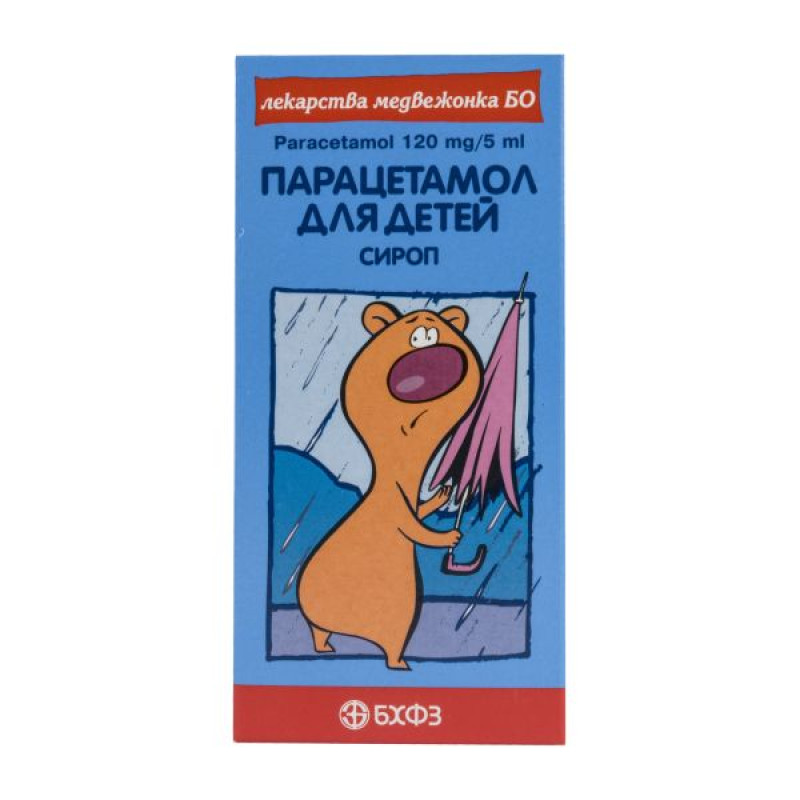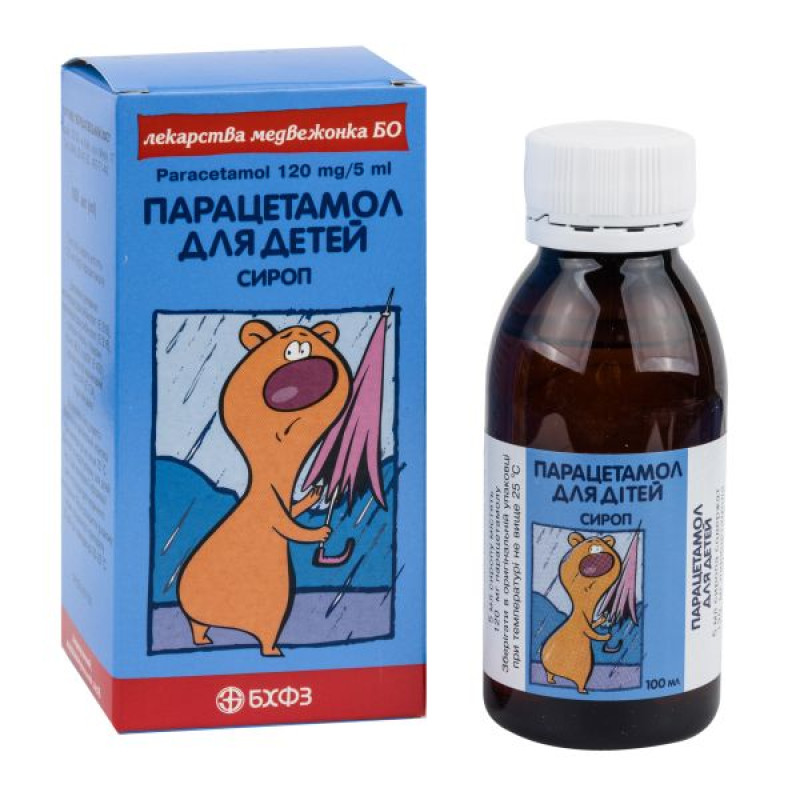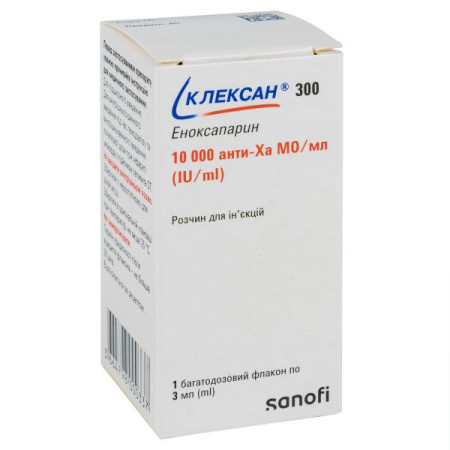Paracetamol for children syrup polymer jar 100 ml

Instructions Paracetamol for children syrup polymer can 100 ml
Composition
active ingredient: paracetamol;
5 ml of syrup contain 120 mg of paracetamol (based on 100% dry matter);
excipients: methyl parahydroxybenzoate (E 218), propyl parahydroxybenzoate (E 216), propylene glycol, glycerin, ethanol 96%, sorbitol (E 420), raspberry flavoring, Ponceau 4R (E 124), purified water.
Dosage form
Syrup.
Main physicochemical properties: transparent viscous liquid, pink in color with a sweet taste and characteristic raspberry odor.
Pharmacotherapeutic group
Analgesics and antipyretics. ATX code N02B E01.
Pharmacological properties
Pharmacodynamics
It has analgesic and antipyretic effects. The mechanism of action is associated with inhibition of prostaglandin synthesis and influence on the thermoregulation center in the hypothalamus.
Pharmacokinetics
After oral administration, paracetamol is rapidly absorbed from the gastrointestinal tract, mainly in the small intestine, mainly by passive transport. After a single dose of 500 mg, the maximum concentration in the blood plasma is reached after 30-60 minutes. It is well distributed in tissues and mainly in liquid media of the body, with the exception of adipose tissue and cerebrospinal fluid. Binding to plasma proteins is less than 10% and increases slightly with increasing dose. Sulfate and glucuronide metabolites do not bind to plasma proteins even at relatively high concentrations. Paracetamol is metabolized mainly in the liver by conjugation with glucuronides, conjugation with sulfates and oxidation with the participation of mixed liver oxidases and cytochrome P450. The hydroxylated metabolite with negative effects, N-acetyl-p-benzoquinoneimine, which is formed in very small quantities in the liver and kidneys under the influence of mixed oxidases and is detoxified by binding to glutathione, can accumulate in case of paracetamol overdose and cause tissue damage. In adults, most of the paracetamol is bound to glucuronic acid and to a lesser extent to sulfuric acid. These conjugated metabolites do not exhibit biological activity. In premature infants, newborns and children in the first year of life, sulfate metabolism predominates. The half-life is 1-4 hours. In patients with cirrhosis of the liver, the half-life is slightly increased. The renal clearance of paracetamol is 5%. The drug is excreted in the urine, mainly in the form of glucuronic and sulfate conjugates. Less than 5% is excreted as unchanged paracetamol.
Indication
Teething pain, toothache, sore throat, fever from colds, flu, and childhood infections such as chickenpox, whooping cough, measles, and mumps (mumps).
Contraindication
Hypersensitivity to paracetamol and other components of the drug, especially parabens (methyl and propyl parahydroxybenzoate); severe liver and kidney dysfunction (including liver and kidney failure); glucose-6-phosphate dehydrogenase deficiency; blood diseases (including severe anemia, leukopenia); congenital hyperbilirubinemia (Gilbert, Dubin-Johnson, Rotor syndrome); alcoholism.
Interaction with other medicinal products and other types of interactions
The drug should not be used simultaneously with other medicines containing paracetamol, so as not to exceed the maximum daily dose of paracetamol.
With the simultaneous use of paracetamol with hepatotoxic drugs, the toxic effect of the drugs on the liver increases.
Drugs that induce hepatic microsomal enzymes (including barbiturates, phenytoin, carbamazepine, primidone, other anticonvulsants, tricyclic antidepressants, oral contraceptives, St. John's wort preparations), ethanol: possible increase in the toxic effect of paracetamol on the liver due to an increase in the degree of conversion of the drug into hepatotoxic metabolites, especially when using high doses of paracetamol.
Barbiturates: reduction of the antipyretic effect of paracetamol.
Do not use simultaneously with ethanol and other drugs containing ethanol.
Probenecid, propranolol: possible enhancement of the effect of paracetamol.
Lixisenatide: Paracetamol absorption may be reduced when administered 1-4 hours after taking lixisenatide.
Chloramphenicol: increased toxicity due to prolonged half-life of chloramphenicol and increased plasma concentration.
Metoclopramide, domperidone: possible increase in the rate of absorption of paracetamol.
Cholestyramine: possible reduction in the rate of absorption of paracetamol.
Warfarin, other coumarins: possible potentiation of the anticoagulant effect with an increased risk of bleeding when using high doses of paracetamol for several days; regular monitoring of the International Normalized Ratio (INR) is recommended; single doses of paracetamol have no significant effect. If necessary, the dose of the oral anticoagulant should be adjusted during treatment with paracetamol.
Diflunisal and other NSAIDs: serum paracetamol levels increase, which increases the risk of hepatotoxicity and nephrotoxicity.
Diuretics: paracetamol reduces their effectiveness.
Antiviral drugs: regular use of paracetamol may reduce the metabolism of zidovudine (increased risk of neutropenia).
Interaction with diagnostic tests: paracetamol may affect the results of blood uric acid determination using the phosphotungstic acid method and blood glucose determination using the oxidase-peroxidase method.
Application features
Do not use with other paracetamol-containing medicines used, for example, to reduce fever, treat pain, flu and cold symptoms, and insomnia. Concomitant use with other paracetamol-containing medicines may lead to overdose. Paracetamol overdose may cause liver failure, which may require a liver transplant or be fatal.
Before using the drug, you should consult a doctor.
The recommended dose and duration of treatment should not be exceeded.
The maximum duration of use without consulting a doctor is 3 days.
If the signs of the disease persist or worsen, it is imperative to consult a doctor.
Patients taking daily analgesics for mild arthritis should consult a doctor before using the drug. When treated with paracetamol at a dose of 60 mg/kg/day, concomitant use of another antipyretic is justified only in case of insufficient effectiveness of paracetamol.
Before using paracetamol, it is necessary to consult a doctor if the patient is taking warfarin or similar drugs that have an anticoagulant effect.
Use with caution in patients with liver and kidney diseases (in these diseases, consult a doctor before using the drug). It should be borne in mind that in patients with liver diseases, including alcoholic non-cirrhotic liver damage, the risk of hepatotoxic effects of paracetamol increases.
Liver dysfunction/hepatic failure has been reported in patients with reduced glutathione levels, e.g. in severe wasting, anorexia, low body mass index or chronic alcoholism. Patients with reduced glutathione levels, e.g. in severe infections such as sepsis, are at increased risk of developing metabolic acidosis when taking paracetamol. Symptoms of metabolic acidosis include deep, rapid or difficult breathing, nausea, vomiting, loss of appetite. You should seek medical attention immediately if these symptoms occur.
With prolonged use of the drug, it is necessary to monitor the composition of peripheral blood and the functional state of the liver and kidneys (the role of paracetamol has not been completely ruled out in the development of nephropathy associated with the use of analgesics).
The medicine contains sorbitol (E 420), therefore patients with rare hereditary problems of fructose intolerance should not take this medicine. It may also cause a slight laxative effect.
The drug contains Ponceau 4R (E 124), methyl parahydroxybenzoate, propyl parahydroxybenzoate, which may cause allergic reactions (possibly delayed).
The drug contains ethanol (alcohol) (in 5 ml of syrup - 125 mg of 96% ethanol). Harmful for patients with alcoholism. Caution should be exercised when using in pregnant and breastfeeding women, children, and patients with liver disease and epilepsy.
The drug may affect the results of laboratory tests for blood glucose and uric acid.
Ability to influence reaction speed when driving vehicles or other mechanisms
This dosage form is used for children.
Use during pregnancy or breastfeeding
There are no standard studies using currently accepted standards for assessing reproductive and ontogenetic toxicity.
A large amount of data on the use of paracetamol preparations in pregnant women indicate neither malformative nor feto/neonatal toxicity. Epidemiological studies on the development of the nervous system of children exposed to paracetamol in utero show inconclusive results. If paracetamol is clinically necessary, it can be used during pregnancy, but at the lowest effective dose for the shortest possible duration and with the least possible frequency of use.
This dosage form is used for children.
Method of administration and doses
The drug is intended for oral use only. The dose of paracetamol for all children is calculated depending on age and body weight. The lowest dose of the drug necessary to obtain a therapeutic effect should be used.
A single dose of paracetamol is 10-15 mg/kg of body weight. The maximum daily dose of paracetamol is 60 mg/kg of body weight.
The drug can be repeated every 4-6 hours if necessary. Do not use more than 4 doses within 24 hours. The interval between doses should be at least 4 hours. The maximum course of treatment without consulting a doctor is 3 days.
Children aged 6 months to 12 years.
In the table, find the dose that corresponds to the child's age. Measure the dose of the drug using a measuring spoon, which has markings of 2.5 ml and 5 ml.
Single doses of paracetamol syrup 120 mg/5 ml for children
| Dose | |
| 6-24 months | 5 ml |
| 2-4 years | 7.5 ml |
| 4-8 years | 10 ml |
| 8-10 years | 15 ml |
| 10-12 years | 20 ml |
Children
The drug is contraindicated for use in children under 6 months of age. This dosage form should be used in children aged 6 months to 12 years.
Overdose
Liver damage is possible in adults who have used 10 g or more of paracetamol; in children who have used more than 150 mg/kg of body weight.
In patients with risk factors, the use of 5 g or more of paracetamol may cause liver damage. Paracetamol overdose may cause liver failure, which may require liver transplantation or be fatal.
Risk factors:
long-term treatment with carbamazepine, phenobarbital, phenytoin, primidone, rifampicin, St. John's wort preparations or other drugs that induce liver enzymes; regular excessive use of ethanol; glutathione cachexia (digestive disorders, cystic fibrosis, HIV infection, starvation, cachexia).
Symptoms of overdose in the first 24 hours: pale skin, nausea, vomiting, anorexia and abdominal pain, increased activity of "liver" transaminases and increased prothrombin index. Liver damage may become apparent 12-48 hours after overdose. Glucose metabolism disorders and metabolic acidosis, hepatocellular failure, hepatonecrosis may occur. In severe poisoning, liver failure may progress to hypoglycemia, encephalopathy, hemorrhages, cerebral edema, coma and death.
Acute renal failure with acute tubular necrosis, accompanied by severe back pain, hematuria, and proteinuria, can develop even in the absence of severe liver damage.
When using high doses, the following are possible:
from the nervous system - dizziness, psychomotor agitation or depression of the central nervous system, impaired orientation and attention, insomnia/drowsiness, tremor, nervousness, anxiety, impaired consciousness, hyperreflexia, convulsions; from the urinary system - nephrotoxicity (renal colic, interstitial nephritis, papillary necrosis).
In case of overdose, cardiac arrhythmia (including tachycardia, extrasystole) and pancreatitis may develop, usually accompanied by impaired liver function and hepatotoxicity, and increased sweating.
With prolonged use of high doses, the development of aplastic anemia, thrombocytopenia, pancytopenia, agranulocytosis, neutropenia, and leukopenia is possible.
Treatment: In case of overdose (even in the absence of symptoms), urgent medical attention and immediate hospitalization are necessary. Symptoms may be limited to nausea or vomiting and may not correspond to the severity of the overdose or the risk of organ damage.
Plasma paracetamol concentration should be assessed 4 hours or later after administration (earlier concentration determinations are not reliable).
In the first hour after taking a large dose of paracetamol, it is necessary to rinse the stomach, induce vomiting, and use activated charcoal.
Acetylcysteine treatment should be administered within 24 hours of paracetamol ingestion, but maximum protection is achieved if administered within 8 hours of overdose. The efficacy of the antidote decreases sharply after this time. Acetylcysteine should be administered intravenously according to the established schedule. In the absence of vomiting, oral methionine may be used as a suitable alternative in areas remote from a hospital.
Symptomatic measures should also be taken.
Adverse reactions
Immune system: hypersensitivity reactions and anaphylactic reactions, including skin and mucous membrane rashes (usually generalized rash, erythematous, urticaria is possible due to the presence of methyl and propyl parahydroxybenzoates in the preparation), itching, angioedema, erythema multiforme exudative (including Stevens-Johnson syndrome), toxic epidermal necrolysis (Lyell's syndrome). If rashes appear, the drug should be discontinued immediately.
Respiratory system: bronchospasm in patients sensitive to acetylsalicylic acid and other NSAIDs.
Nervous system (usually develops when using high doses): dizziness, psychomotor agitation, disorientation.
Digestive system: nausea, epigastric pain, liver dysfunction, increased activity of "liver" enzymes in the blood serum, usually without the development of jaundice, hepatonecrosis (dose-dependent effect); cases of acute pancreatitis have been reported (usually with overdose). The drug contains sorbitol, which may cause a mild laxative effect.
Endocrine system: hypoglycemia, possible development of hypoglycemic coma.
Urinary system: when using high doses - nephrotoxic effect (renal colic, interstitial nephritis, papillary necrosis), aseptic pyuria.
Side effects of paracetamol are rare and depend on the dose and duration of use of the drug.
If any side effects occur, the drug should be discontinued immediately.
Expiration date
3 years.
After opening the bottle, the shelf life of the drug is 30 days at a temperature of 20-25°C.
Storage conditions
In the original packaging at a temperature not exceeding 25 °C.
Keep out of reach of children.
Packaging
100 ml in a bottle, 1 bottle or jar in a pack with a dosing spoon.
Vacation category
Without a prescription.
Producer
Public Joint Stock Company "Research and Production Center "Borshchagov Chemical and Pharmaceutical Plant".
Location of the manufacturer and its business address
Ukraine, 03134, Kyiv, Myru St., 17.
There are no reviews for this product.
There are no reviews for this product, be the first to leave your review.
No questions about this product, be the first and ask your question.










